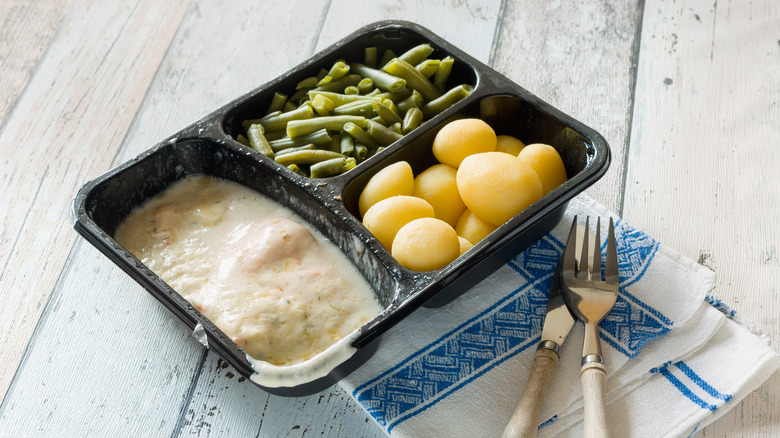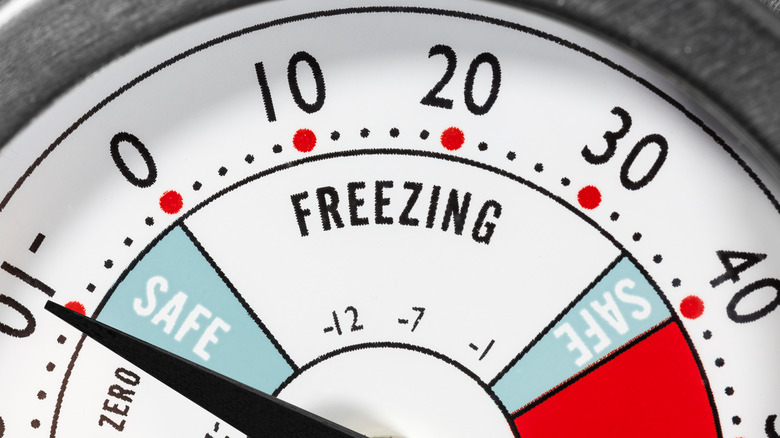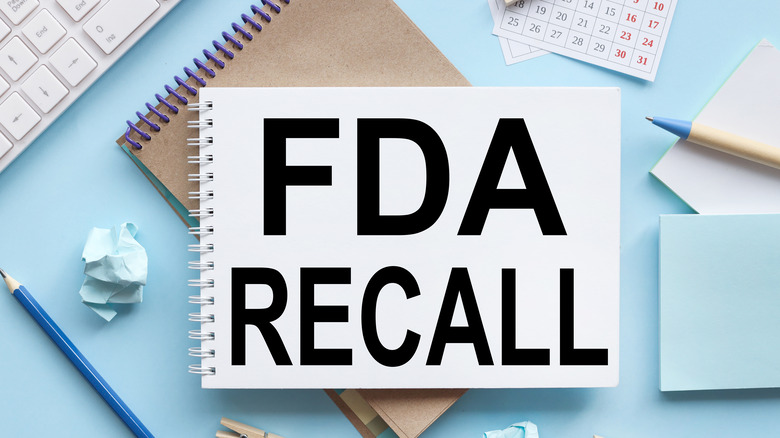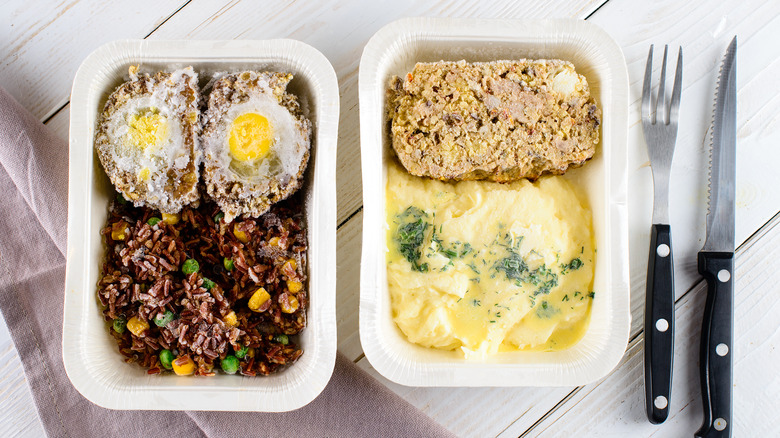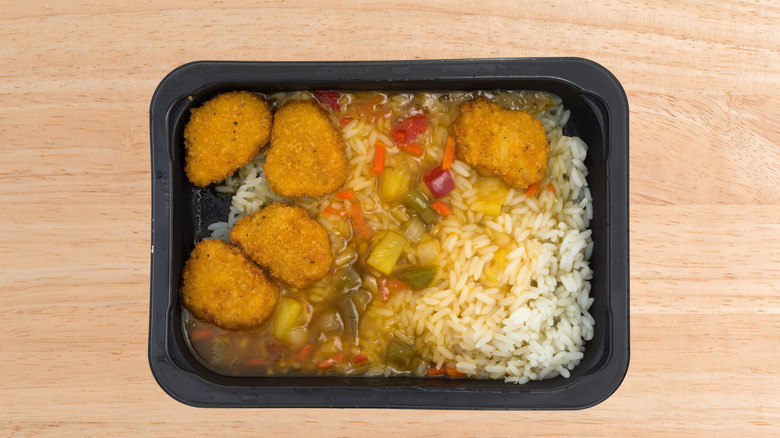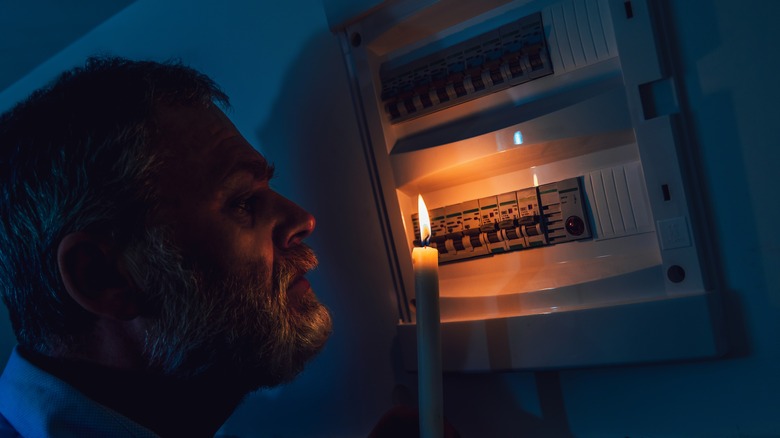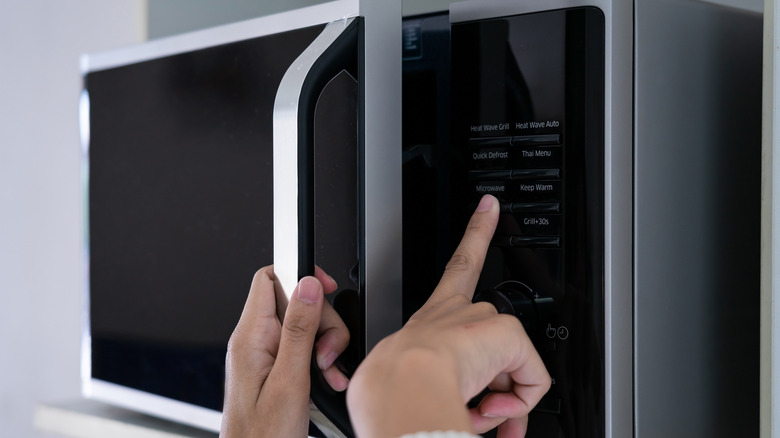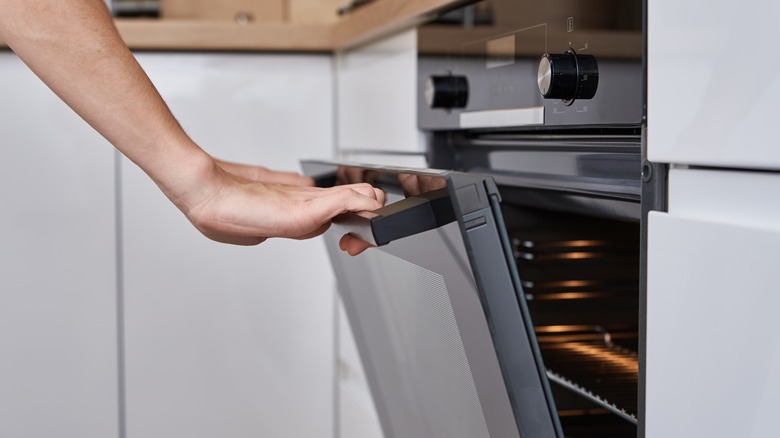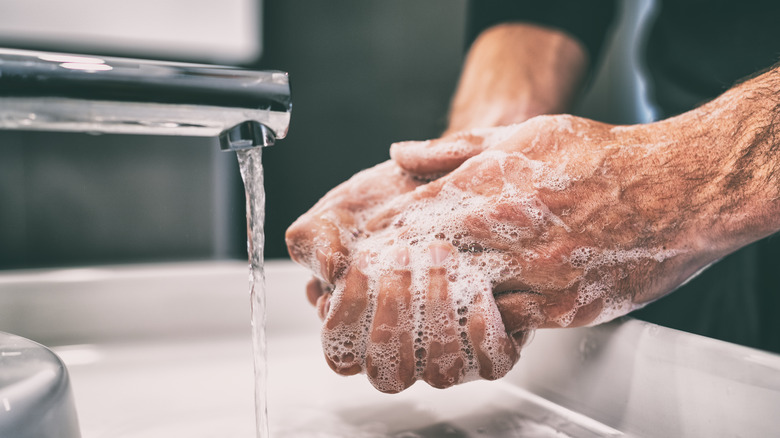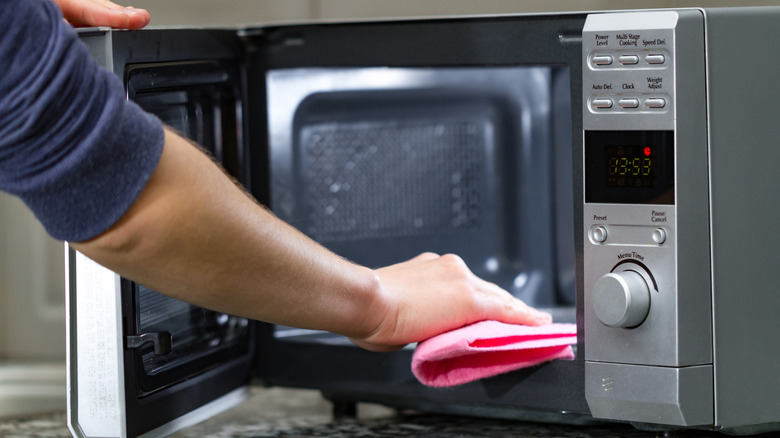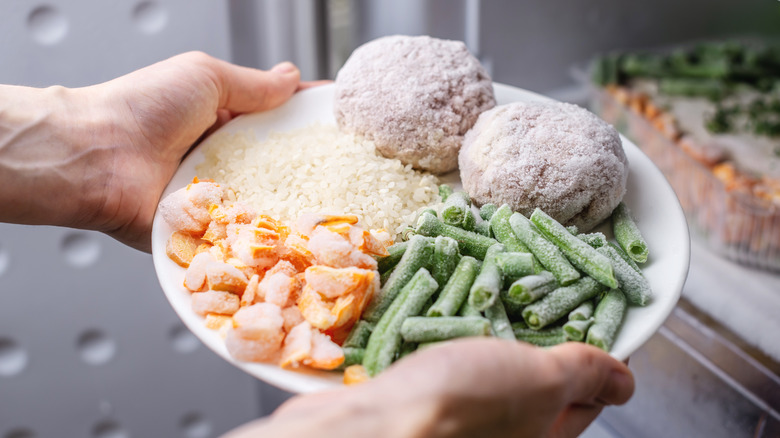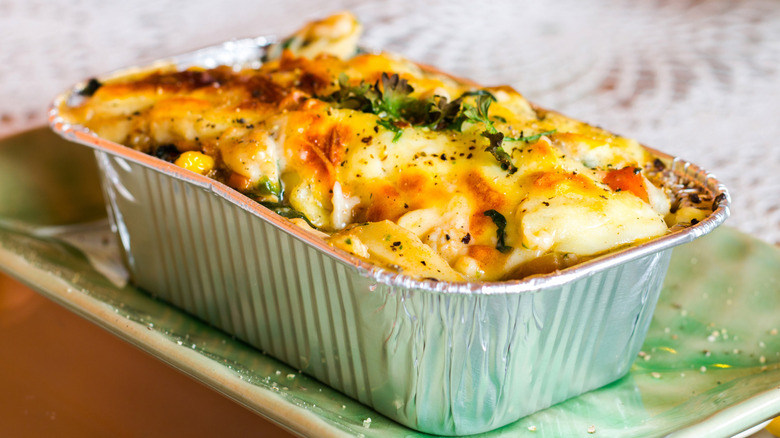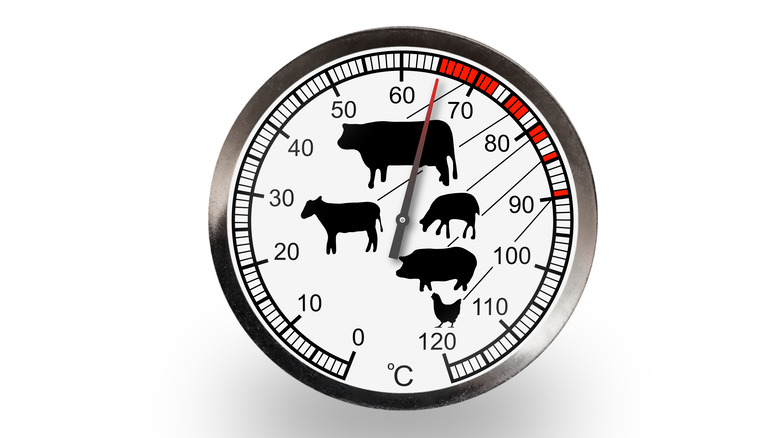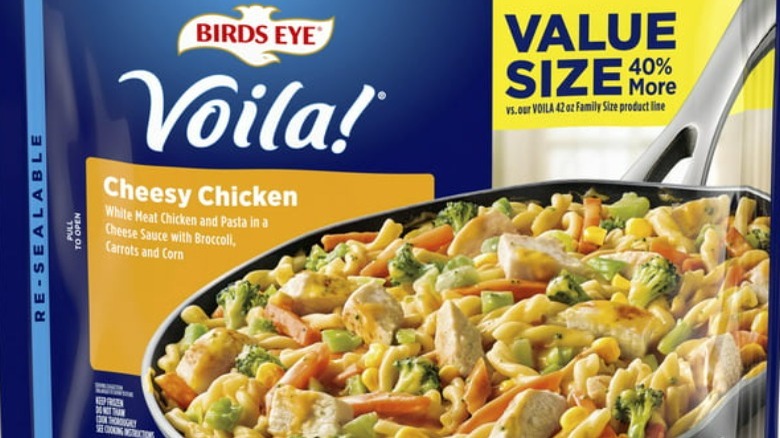14 Mistakes Everyone Makes With Frozen Dinners
We may receive a commission on purchases made from links.
If you're one of the over 127 million people in the U.S. who eat frozen dinners, there's a good chance you've made a mistake or two in preparing them (via Statista). Sure, you've probably been cooking frozen cuisine since you first learned how to use the microwave. But even the best cooks (and microwave cooks) make mistakes they don't realize they're making. Most of the mistakes we make when cooking frozen meals relate to ensuring the food is at a safe temperature, not using the best cooking methods, cross-contamination issues, and quality issues.
While some of the mistakes we make simply affect the quality of our meals, other mistakes we make can affect food safety. So, even if you think you know everything about making a frozen dinner, you'll still want to take a look at our frozen dinner cooking tips just in case you can learn a thing or two.
1. Not keeping frozen dinners cold enough after purchase
Keeping frozen dinners frozen between the grocery store and your home freezer is essential for food safety. The Food and Safety Inspection Service (FSIS) of the U.S. Department of Agriculture (USDA) says that keeping food frozen keeps any bacteria, yeast, or mold present in the food inactive. However, if you let your frozen dinner thaw out between the store and home, these microbes have a chance to multiply to dangerous levels. If you allow frozen food to stay above 40 degrees Fahrenheit for longer than two hours, you should toss it.
At the very least, you should put your frozen dinners in an insulated bag to keep them frozen between the store and home. However, if your favorite supermarket (like Trader Joe's) is a long way from home or it's an especially hot summer day, you'll need to put in a little more effort. New City Moving says it's best to transport frozen food in an ice chest filled with ice, cold packs, or dry ice. To prevent microbial growth, the cooler's temperature shouldn't reach above 40 degrees Fahrenheit. Packing all your frozen food tightly together without any air pockets can help keep everything frozen longer.
2. Not ensuring the freezer is staying cold enough
The USDA says the best temperature for storing frozen food like frozen TV dinners is zero degrees Fahrenheit. If you keep your freezer below zero, you will inactivate microbes and likely kill any parasites like trichina. It's important to note that the temperature in your freezer should never reach above 40 degrees Fahrenheit, or your food will be in the danger zone for microbial reactivation and growth.
Because internal freezer thermostats sometimes fail, the FDA suggests purchasing a freezer thermometer to put in the freezer. If you check it occasionally, you should be able to feel confident that your food is staying at a safe temperature. You can buy a pack of two freezer thermometers (one for your refrigerator freezer and one for your chest freezer) for around $6 to ensure all your frozen foods stay in the safe zone.
According to the FDA, if you notice any freezer burn on your frozen dinner when you open it, it doesn't mean it has reached an unsafe temperature. Many times, you'll find freezer burn simply because the package wasn't sealed tightly, causing areas of your frozen dinner to dry out.
3. Forgetting to look for recalls on frozen dinners that have been in the freezer for a while
It's easy to forget to pay attention to food recalls related to frozen dinners. If you've had a frozen dinner in the freezer for a while, it's a good idea to check the FDA's list of food product recalls to avoid food poisoning.
FoodSafety.gov says that you may be able to return the product to the store for a refund. However, if it's been too long or you don't have your receipt, you should dispose of the product, so nobody else will try to eat it. You should also clean any surfaces or utensils the product has touched with warm, soapy water. Then, wipe everything down with bleach (one tablespoon of bleach to a gallon of water). If you accidentally eat a recalled frozen dinner and think you've contracted a foodborne illness from it, the FDA says you should contact your healthcare provider to report your symptoms and receive treatment.
4. Letting frozen dinners stay in the freezer too long
According to FoodSafety.gov, frozen food will keep indefinitely when you store it continuously at zero degrees Fahrenheit or below. So, you can still eat that box of Hungry Man that's been sitting in the bottom of your freezer for a year, but it's not going to have the same taste quality as it would if you had eaten it within a year of the purchase date (via FoodSafety.gov).
The FDA says that the longer you leave food like TV dinners in the freezer, the more the food quality will decrease. You can expect the meal to taste less flavorful, not smell as nice, have an off-color, and be less tender or juicy than it would have been if you had eaten it sooner. It may taste more like the freezer or the container it's in and less like the delicious frozen meal you were expecting. If it's freezer-burned, you may decide to toss the whole frozen meal out for quality purposes.
5. Not thawing frozen dinners safely
Any microbes in your frozen meal remain dormant while frozen. However, they will start to multiply if they stay long at temperatures between 40 and 140 degrees Fahrenheit. So, thawing your frozen dinner on the kitchen counter is a bad idea.
The USDA suggests three methods for safely thawing foods like frozen meals: refrigerator thawing, cold water thawing, and microwave thawing. In the fridge, the frozen meal can stay below 40 degrees Fahrenheit while it thaws. Just be sure to check the fridge temperature before you start. Cold water thawing can be safe if you keep the food in a leak-proof package or plastic bag to keep bacteria and water out of the package. Just submerge the bag in cold water, changing the water every half hour. The process will take 2-3 hours for a 3-4 pound frozen meal. You can also thaw a frozen dinner in the microwave as long as you cook it immediately after defrosting it.
Of course, some single-serving frozen TV dinners do not advise thawing before popping them in the microwave, so just be sure to read the directions on the box.
6. Not throwing away frozen dinners after a long power outage
If your power goes out, the best thing you can do for your frozen dinners is to keep the freezer doors closed. According to the USDA, if your freezer is full, it should hold its temperature for 48 hours. However, if the freezer was only half full, it's only likely to keep its temperature for 24 hours. After that, you'll want to transfer any frozen dinners or other frozen food to ice-filled coolers. Alternately, the USDA says that 50 pounds of dry ice can keep an 18-cubic-foot chest freezer cold enough for 48 hours.
When the power comes on, the FDA says you should check your freezer thermometer immediately. If the thermometer shows that the freezer is still 40 degrees Fahrenheit or below, it's safe to keep your frozen dinners, even if they've unfrozen during the power outage. If your TV dinners are still frozen, still contain ice crystals, or if a kitchen thermometer shows that they're still below 40 degrees Fahrenheit, they're safe to eat or refreeze.
According to the USDA, frozen meals at the bottom or back of the freezer should stay frozen longer. However, if you have any doubts about whether your TV dinners stayed above 40 degrees Fahrenheit for longer than two hours during the power outage, you should throw them out.
7. Not using proper microwaving methods to cook your frozen dinner
Did you know there are correct and incorrect ways to microwave food? If you don't microwave frozen dinners correctly, you're likely to end up with a meal that's overdone in some spots and not cooked through in others. Following the directions on the package can help, but there are other microwave cooking tips to follow for the best results.
According to GE, there's actually a correct way to arrange your frozen dinner in the microwave. Thicker pieces of food (like meat) should be located on the outside edge of the rotating plate, while thinner, smaller items should be toward the middle. To accomplish this, you should place your microwavable meal on one side of the rotating plate rather than in the center. Stirring your frozen dinner regularly and setting the food to rotate can help prevent cold spots in your meal. If you notice that some areas are cooking while others are staying cold, you may need to rotate the dinner.
Some microwavable meals come with instructions to let your food sit before eating. This sitting time is not about whether or not the food will burn your tongue, so don't get in a hurry. Allowing your TV dinner to sit after microwaving provides an extra cooking period that can prevent unwanted cold spots and bacteria (via Gadget Review).
8. Using the microwave instead of the oven to cook your frozen dinner
Yes, it takes longer to pre-heat and cook a frozen dinner in the oven than in the microwave. However, most frozen meals taste better if you cook them in the oven. With microwaves, you're likely to end up with some spots that are overly hot while others are still frozen. Meanwhile, ovens cook more evenly. Quora commenter Joseph McCray points out that oven-cooked food is likely to "retain moisture, texture, and flavor" better than microwaved food.
While the microwave cooks a frozen meal faster, Mark Becker makes the point on Quora that you actually end up spending less time in the kitchen when you use the oven because you don't have to stop the cooking process to stir, rotate, and flip. He also mentions that cooking your food in the oven will allow you to use an oven probe thermometer to monitor the internal temperature of the food to ensure that the food has reached a safe temperature before you remove it from the oven.
Of course, not all frozen dinners work in the oven. If the packaging has oven instructions, you can be sure the packaging won't melt. If the package is not microwavable, you can always transfer the food into an oven-safe container to cook it in the oven. Chances are, it will improve the flavor and texture of your frozen meal.
9. Not avoiding cross-contamination
Even if you freeze and cook your TV dinner at the right temperature, you're still at risk of catching a foodborne illness from cross-contamination According to the Minnesota Department of Health, the most common ways we spread germs to our food is from our nose, mouth, eyes, or hands. We most often transfer germs to our hands from touching our face, unclean surfaces, other food, infected children, and pets. Washing our hands often can help with most of these issues. Germs can hang out on countertops, utensils, cutting boards, and appliances. Always wash your hands with soap and hot water after you touch your face, handle other food, use the bathroom, touch a sick child or change their diaper, handle a pet, or touch any surface. In fact, it's best to wash your hands immediately before touching any food in the kitchen just to be safe. If part of the cooking process involves slicing open or punching holes in the plastic covering your frozen dinner, you should always use a clean knife or fork.
Washing your hands, surfaces, and utensils with soap is essential to remove germs. According to Live Science, you should wash with soap for at least 20 seconds and rinse with hot water to kill microbes that cause disease and wash them down the drain. Soap can penetrate and destroy the fatty membranes surrounding bacteria and some viruses, usually killing them.
10. Cooking frozen dinners in a dirty microwave
If you've been cooking your frozen dinners in a dirty microwave, you shouldn't be. Those stalactite spatters hanging from your microwave ceiling have the potential to drop into your food. Food safety specialist Ben Chapman, told Vice the heat from the microwave should kill off any pathogens in your food stalactites, but finding pieces of last month's crusty spaghetti leavings in your warmed-up mashed potatoes won't be appetizing.
The worst case scenario with using a dirty microwave is that it could contain bad bacteria that have grown in numbers since you last used it, which could transfer to your hands, other kitchen surfaces, or your food. In one study, July Torruellas-Garcia, Ph.D., found a shocking amount of E. coli after swabbing the inside of a home microwave. She said, "We use [the microwave] to cook our food, but also to defrost meat. Raw meats carry bacteria like E. coli and Salmonella. Sometimes, the food splatters around the microwave and we don't always clean it" (via Microban).
Just wiping out spills and splatters from your microwave may not be enough. Chances are, you've been cleaning your microwave wrong. For extra cleaning power, you'll want to steam the inside of your microwave with a bowl of water and lemon juice or vinegar before wiping the inside with soapy water.
11. Assuming all the ingredients in a frozen dinner are pre-cooked
Even if the meat or other ingredients in your frozen cuisine have grill marks or browned breading, it doesn't necessarily mean they're fully cooked. Sometimes, they can still be partially raw. The USDA says you will often see labels on frozen meals that say that they are "cook and serve," "oven-ready," or "ready to cook," which should always be an indicator that thorough cooking is necessary.
Twenty-two percent of participants in a study by the U.S. Department of Agriculture Food Safety and Inspection didn't realize that raw meat in a frozen chicken entree was still raw (via Urban Citizen). Thus, looks alone aren't always a good indicator of whether or not the food in your frozen meal is pre-cooked. No matter what you assume about your food, you should always follow the cooking directions on the package to ensure you're cooking it long enough. Following the directions is especially important if you are cooking potentially-raw meat since it can harbor pathogens like E. coli or Salmonella. Not knowing whether your ingredients are starting from raw or not is also a good reason to wash your hands.
12. Not cooking your frozen dinner thoroughly
To avoid foodborne illnesses, it's always necessary to cook your frozen food thoroughly. Cooking is even more important if your entree contains meat. While different meats require different cooking temperatures to stay safe, the USDA suggests always heating your frozen food to an internal temperature of 165 degrees Fahrenheit to ensure that it's safe to eat. The food danger zone for bacteria growth is 40 to 140 degrees Fahrenheit.
So, if you don't heat your frozen dinner hot enough, you're putting yourself at risk for food poisoning. If you don't heat it enough and then let it sit out on the counter before getting around to eating it, any pathogens that are alive in the food can multiply to dangerous levels that can make you sick. Even if you nuke it briefly to warm it back up a little, if the food temperature isn't high enough to kill pathogens, you're putting yourself at risk.
13. Not checking the temperature of frozen dinner meats with a thermometer
The outside color and temperature of meat are never reliable for determining if it's done on the inside. Since some frozen meals come with uncooked or undercooked meat, it's essential that you check the internal meat temperature before eating. The best way to determine if you've cooked your frozen dinner thoroughly is to use a food thermometer. The USDA says the internal temperature of beef, pork, lamb, or veal should be at least 145 degrees Fahrenheit. Ground meat is safe at 160 degrees Fahrenheit. Meanwhile, poultry needs to reach 165 degrees Fahrenheit, whether it's ground or whole. To be safe, the USDA recommends cooking any frozen dinner to at least 165 degrees Fahrenheit, which should kill the most common food pathogens.
If you're cooking your frozen meal in the oven, you can keep the probe of a meat thermometer in the meat while you cook it so that you don't have to open the oven door before it's ready to eat. However, since meat thermometer probes are stainless steel, you'll have to resort to testing the internal meat temperature after cooking in the microwave.
14. Not handling the bag properly if there are more servings inside for the future
If you buy a large bag of frozen food that you can use to make multiple meals, preventing ice crystals is essential to maintain taste and texture quality. After all, you want every serving of your frozen dinner to taste as good as the first one did. According to Whirlpool, ice crystals form when you place an item into the freezer that is warmer than the freezer or has condensation on it. So, if you open a large bag of frozen food and let it sit on the counter for a while before putting the rest back in the freezer, you're creating the perfect environment for ice crystal formation.
Healthline says that when moisture migrates to the surface of your food and forms ice crystals, it can dehydrate the inside of your food, leaving it drier, shriveled, and tougher. Your food may undergo color and flavor changes or even develop freezer burn, especially if they stay in the freezer longer or there's oxygen in the bag that can replace the moisture in the food. To prevent degradation in your multi-serving frozen meals, remember to return them to the freezer quickly and remove as much air from the bag as possible when you seal it.
